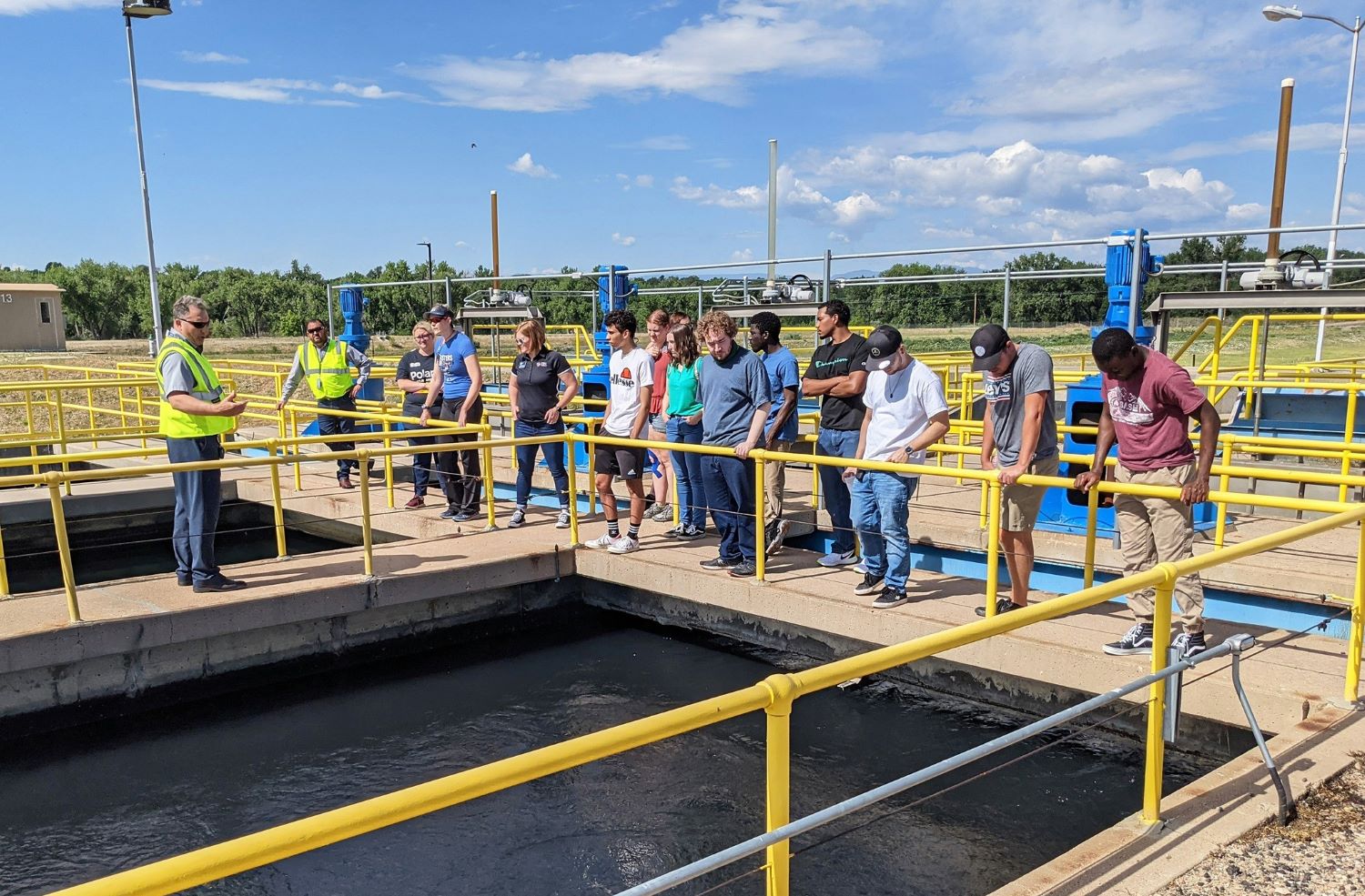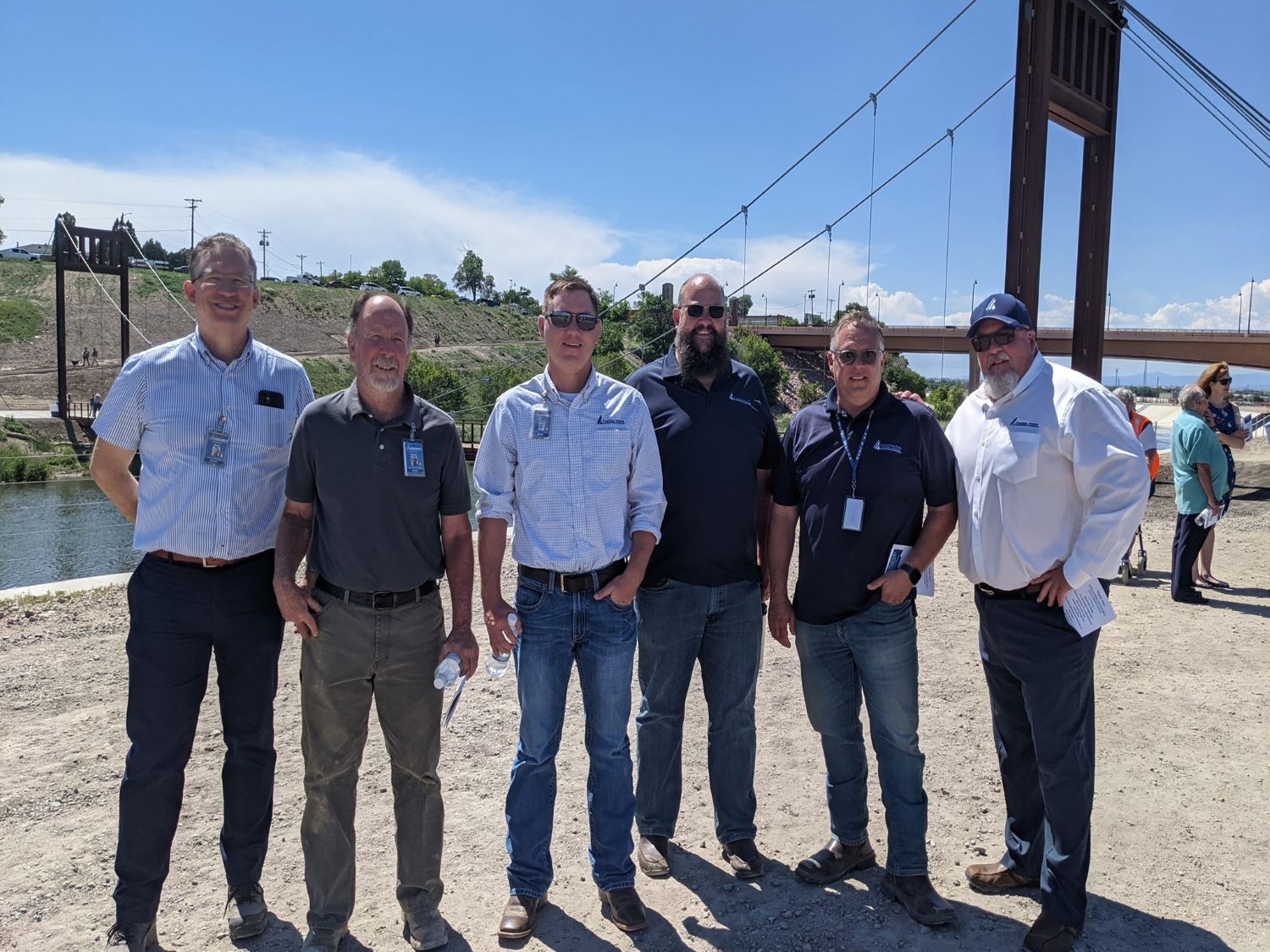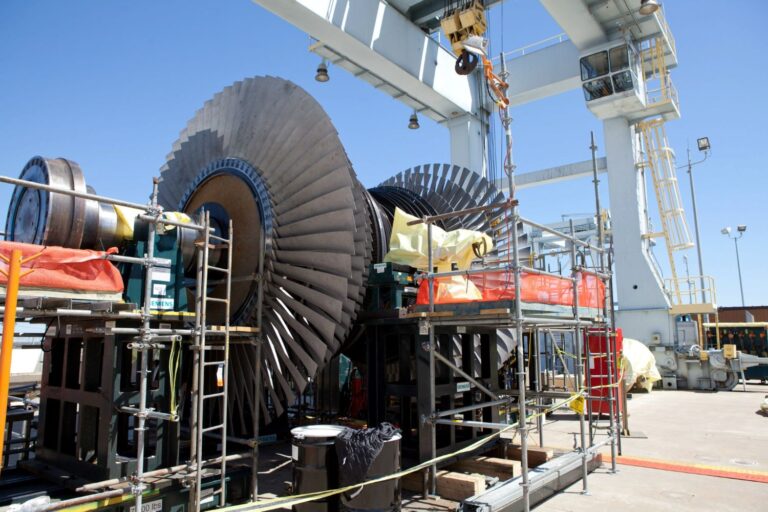Pueblo Water and ICM Colorado Dive in a ‘Sound-simple’ Hydroelectric Project
Colorado’s lowest and highest elevations Colorado Springs is higher at 6,035 feet, but Colorado Springs to the south is similar at 5,003 feet. The Front Range Urban Corridor’s southernmost point, Pueblo, is 4,692 feet high.
For Pueblo Water, having its primary water source at a high altitude has always been a mixed blessing. The water flows downhill to the facility without the need for a pump, but it does so at a considerably higher pressure than the treatment process can handle.
For quite some time, the go-to solution has been pressure relief valves. However, there’s a new initiative underway at the utility located near the base of the Rocky Mountains. They are exploring the possibility of harnessing this pressure to generate electricity by installing two hydro turbines to capture the energy from the high-pressure flow.
To fulfill this objective, the Board of Water Works of Pueblo made the decision in 2022 to issue a solicitation called the “Kevin F McCarthy Hydroelectric Plant Project.” The primary goal of this project is to solicit proposals for the installation of two hydroelectric water turbines, which the Board has already acquired. These turbines will be situated at the Whitlock WTP and will be ready for installation by the selected contractor.
Before diving in the main course, let’s examine the status of the local systems here.
Thwarting Progress – Local Old System Remains
According to Director of Operations Matt Trujillo, due to the difference in elevation, the water entering our treatment plant registers at approximately 85 psi. When we initially laid down the raw water pipeline, spanning about five miles from the Pueblo Reservoir, we had to incorporate measures for energy dissipation within a pressure dissipation building.
Since 2003, Pueblo’s been relying on three valves to reduce that 85 psi down to a more manageable range of 10 to 12 psi, making it suitable for the treatment process. However, they are now in a position to leverage this high pressure to our advantage by harnessing its energy to generate power.
Currently, the water flows from the reservoir to Whitlock’s pressure dissipation building, where it undergoes a reduction in pressure to reach a usable level.
“That pressure is released through valves inside the building, with that constant noise you hear as a reminder of wasted energy,” Director of Operations Matt Trujillo said.
The pressure relief valves, in a 30-by-30-foot building, get the job done, but they don’t do it quietly. “You drive by, and you can just hear the wasted energy, the noise and vibration coming out of there,” Trujillo says. The hydro turbines will be installed in parallel to the existing pressure-dissipation plumbing, so the old valves can still be used if needed.

“A majority of the flow will be directed through the turbines,” says Trujillo. “If we need supplemental flow, or if we have to take down the turbines for maintenance, we can still run through the pressure dissipation building.” Pueblo’s Whitlock Water Treatment plant, with 84 MGD capacity, has average flows of 22-25 MGD in summer and 10-12 MGD in winter.
This was where the need for more turbines at the Whitlock WTP reached its peak. Indeed, the Board of Water Work of Pueblo felt this, that’s why they dedicated the site of its new hydroelectric power plant at the Whitlock Treatment Facility in 2021, which was named in honor of the late, longtime water board member Kevin McCarthy.
Overcome Obstacles – Bringing the Silver Bullets to the Whitlock WTP
It hasn’t been an easy road, but Trujillo always believed that producing power from the pressure of the water supply was inevitable: “We’ve been looking at this for 15 years. The regulatory side of things presented the most challenge. When we got really serious, we called in a professional.”
The Federal Energy Regulatory Commission issued the permit for the hydro power project, despite the fact that the federal Bureau of Land Management manages the Lake Pueblo Reservoir, from which the utility obtains the majority of its supply.
Pueblo Water has already acquired the turbines for the project. However, there has been a delay in the project’s progress due to the fact that the installation costs exceeded the initial estimates.
As Director of Operations Matt Trujillo explains, “We handled the procurement for the turbines ourselves and then solicited bids for the construction phase. The cost estimates from the bids returned considerably higher than what we had anticipated. Consequently, we are now actively working to minimize the amount of work we need to contract out.”
Trujillo estimates that construction is likely to commence in late 2022, assuming there are no shortages of necessary materials.
He adds, “On paper, the project may appear straightforward, but in reality, it’s a bit complex. We need to ensure that all the equipment is in place to capture power generated on-site, blend it with power from the municipal electric company, and at the same time, guarantee that the power we generate doesn’t flow back onto their grid, potentially causing issues for them.”
The generators will create noise once this project is fully functioning, although not as much as the energy dissipation valves. And when people hear noise as they pass the treatment facility, it will be from energy production rather than energy waste.
The hydropower plant’s two turbines, made by the Austrian business Gugler Turbines, will run one at a time to maximize electricity generation all year long.
When the reservoir’s flows are between 8 million and 24 million gallons per day, the smaller 0.5-megawatt turbine will turn on, and the larger one-megawatt turbine will work when the flows are between 24 million and 62 million gallons per day.
According to Trujillo, the plant is anticipated to produce 3,500 megawatt hours per year. The cost of the turbines is approximately $1.15 million, which also covers an estimated shipping expense of about $80,000 from Austria.

The plant is dedicated and named in honor of McCarthy, who dedicated over 32 years of service to Pueblo Water’s Board of Directors before his passing due to cancer in 2019.
“Kevin was a deep thinker and able to grasp concepts and understand how they fit into the global landscape of water quicker than most,” Pueblo Water executive director Seth Clayton said. “Kevin was always focused on the future of Pueblo and this utility.”
“I’m so very excited to be able to dedicate this groundbreaking in Kevin’s honor and have the opportunity to publicly thank him for all his contributions to the success of this organization.”
The Board had the instruments; however, they didn’t know how to “play”, or process the installation. That’s why the Board of Water Work was sending the construction contract out to find endeavors for the installation phase.
Finding the Ideal Endeavor for the Installation Phase
The proposed work involves the installation of two hydroelectric water turbines at the Whitlock Water Treatment Plant (WTP). These turbines have already been acquired by the owner and are ready for installation by the contractor. These turbines will generate hydroelectric power as part of the plant’s energy supply.
In addition to the turbines, the contractor is responsible for installing various additional equipment that has also been procured by the owner. This equipment includes a generator, an exciter, a control system, and a Hydraulic Power Unit (HPU). The HPU comes with electric motors, starters, controls, and wiring, all mounted on a skid.
Alongside this, the project also involves installing associated piping on the skid, strainers, butterfly valves, actuators, and process piping. The specific locations for these components are detailed in the project drawings.
As part of the project scope, a new metal building will be constructed to house the hydroelectric turbine and equipment. This building will serve as the central hub for the hydroelectric power generation system.
It will also include miscellaneous yard piping connections to facilitate the functioning of the equipment. The construction of this building is essential to protect and house the equipment in a suitable environment.
That’s what the contractor needs to know before jumping in and applying for the contract. Understanding the significance of this building’s construction and its role in safeguarding and enabling the equipment is paramount. This must be a well-prepared phase before getting evaluated by the Board of Water Work.
The Art of Evaluation – Sieving for True Gold, Removing the Rest
Pueblo, a city in Colorado, has its own municipal water utility known as the Board of Water Works of Pueblo. This board is responsible for managing the city’s water supply, treatment, distribution, and related services.
The relationship between Pueblo and its Board of Water Works typically involves a close collaboration to ensure a reliable and safe water supply for the city’s residents, businesses, and industries.
The board is often structured as a separate entity or government agency tasked with overseeing water-related matters, while the city government retains a level of oversight and coordination.
Sending out contracts and evaluating bidders are also tasks attached with the organization. In this contract of installing 2 turbines, the process was throughout as always.

In the evaluation process, the Board held the authority to reject any or all submitted Bids, including those that were nonconforming, nonresponsive, unbalanced, or conditional. Furthermore, the Board could reject the Bid of any Bidder who was found to be non-responsive after a reasonable inquiry and assessment.
The Board also retained the discretion to reject a Bid if it deemed that awarding the contract to that Bidder would not have been in the best interest of the Project. Additionally, the Board had the flexibility to waive informalities not related to price, time, or changes in the Work, and to engage in negotiations regarding contract terms with the Successful Bidder.
It’s important to note that the Board did not consider multiple Bids for the same Work from an individual or entity under the same or different names. Any reasonable suspicion that a Bidder had an interest in more than one Bid for the Work could have resulted in the disqualification of that Bidder and the rejection of all associated Bids.
In the evaluation of Bids, the Board assessed compliance with the specified requirements and any requested alternatives, unit prices, or additional data outlined in the Bid Form or prior to the Notice of Award.
Additionally, the qualifications of Bidders were taken into account, including the qualifications and experience of proposed Subcontractors, Suppliers, and other entities or individuals involved in the Work.
The Board also considered factors such as operating costs, maintenance requirements, performance data, and guarantees related to major materials and equipment proposed for incorporation in the Work.
To facilitate a comprehensive evaluation, the evaluation committee conducted necessary investigations to assess the responsibility, qualifications, and financial capability of Bidders, as well as proposed Subcontractors, Suppliers, and other entities or individuals involved in delivering the Work in accordance with the Contract Documents.
This evaluation process was critical in ensuring that the selected Bidder was capable of meeting the project’s requirements and objectives effectively. And ultimately, the Contract was awarded to the Bidder whose evaluation indicated to the construction that such an award served the best interests of the Board of Water Work of Pueblo.
And after a comprehensive process, the final contract winner has been revealed in 2022, that was ICM – Industrial Constructors/Managers, Inc.
Teamed up with ICM to Finish the Top-Notch Engine
The winning contractor was Industrial Constructors/Managers, Inc. (ICM), located locally at in Pueblo, Colorado, with a contract value of $4,580,583.00 awarded on December 20, 2022.
Established in 1983, ICM has earned quite an impressive reputation in the construction industry and proudly acknowledges their greatest assets – their employees who helped to establish that reputation.
As an industrial general contractor, ICM Colorado is an expert at design-build projects. They are able to manage these projects from concept to completion; resulting in on time, on schedule, on budget projects delivered with safety standards and quality assurance second to none.
ICM prioritized safety with a well-established accident-prevention policy, making it an integral part of project planning, quality control, and job efficiency. Quality management was a core value for ICM, involving everyone from top management to field employees. They fostered a culture of learning from construction issues through regular Quality Alerts.
ICM’s skilled Millwrights specialized in installing and maintaining critical equipment, while their Ironworkers handled structural work, including steel frames, equipment support, and safety platforms. Carpenters laid the foundation and handled concrete installations, and Pipefitters provided solutions for industrial and process piping needs, working with various materials.
ICM has earned certifications from the American Society for Quality, the National Board Inspection Code, the American Welding Society, the American Institute of Steel Construction, and the Better Business Bureau, to name just a few. Whether it is a one-day job, or a 25-million-dollar long-term project, ICM devotes its highest level of expertise, innovation, quality, and skills to every customer.

ICM will collaborate with the Board of Water Works of Pueblo to install two hydroelectric water turbines at the Whitlock Water Treatment Plant.
This involves careful planning, precise installation, and rigorous safety measures. ICM’s team will position the turbines, connect them to necessary equipment, and construct a dedicated building to house and protect them.
Enabling Local Advancement Through Cost Efficiency
The utility has acquired both a 1.0 MW and a 0.5 MW hydro turbine. Peak power generation is expected to reach 835 kW, and the annual energy production is estimated at 3,500 MWh. As Trujillo explains, “While this output represents a relatively small fraction of our total energy consumption, likely falling in the 10-20% range, it still translates into significant savings—approximately $400,000 per year when combined with other metering changes.”
The plant receives its raw water through a 66-inch pipe buried approximately six feet underground. The turbines will be connected to this underground pipe, and the connecting pipes will emerge through the floor of a new building. From there, the pipes will turn horizontally and pass through the turbines. Subsequently, the water will be directed back underground to reconnect with the supply pipe that feeds the treatment plant.
The smaller turbine will be utilized during the winter months when water demand is lower. Although it may not generate as much electricity, it will operate more efficiently. In the summer, when water flow is higher, the larger turbine will come into play to maximize power generation.
Pueblo Water has numerous pressure zones and storage tanks since it supplies a sizable distribution region (580 miles of underground pipelines) at various elevations. Trujillo states, “We try to get a healthy pressure for everyone in town, anywhere from 40 to 100 psi.” Moving water to additional storage tanks is the only method to accomplish that.
That creates a substantial power demand for pumps and motors to move the water through the system; the new hydro power will help meet that demand.
Pueblo sources its drinking water from the Arkansas River, which is transported into the utility’s system through large, high-pressure pipelines. Currently, this water passes through specialized equipment and valves designed to slow it down and release the built-up pressure before it enters the initial treatment ponds.
During a recent tour of the facility, Matt Trujillo, the Director of Operations at Pueblo Water, pointed out the noise and vibration present in this process. These are clear indicators of energy being wasted, which the utility intends to harness for power generation.
Trujillo explained, “We will redirect this water through our new hydro facility. It will capture the water’s energy on-site, generate electricity, and then return the water to our production process.”
Once the new hydroelectric plant is finished in 2024, it has the potential to process up to 62 million gallons of water daily. This estimated $10 million project encompasses two turbines: a larger one-megawatt unit designed to manage high water flows and a smaller half-megawatt unit for the lower flows experienced during the winter months.
According to Trujillo, this system is expected to generate 835 kilowatts of power, contributing significantly to meeting a portion of the utility’s electricity needs.
“We’re trying to shave our peak demand,” he said. “So, we’ll have special equipment in place to make sure that power is not pushed back on the grid, but it’ll be used internally here on the site.”









